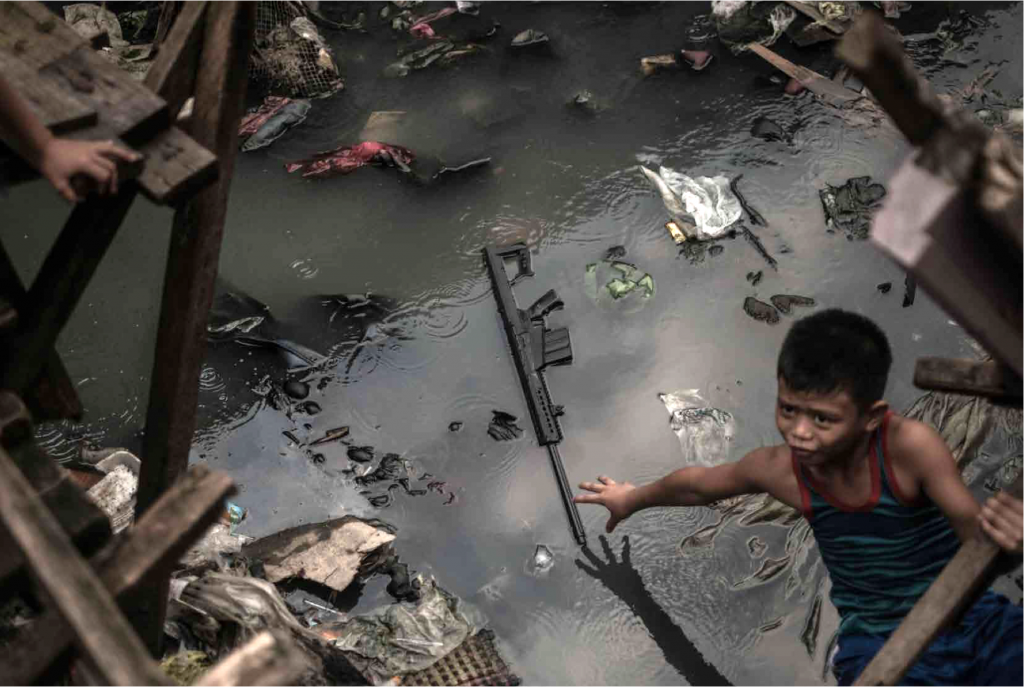(THIS ARTICLE IS MACHINE TRANSLATED by Google from Norwegian)
A red plastic bag, a black shoe, four coffee cups in Styrofoam, a bra, a metal box, an old, broken mobile. Color images of individual objects can become aestheticized artistic expressions when they stand alone. But here it is mostly black and white images, with objects that are put together into a larger whole. A load of waste, quantities of plastic, and resources lost. It all becomes nauseating to watch.
Manila's chaos
Colonial Manila in the 1800 century must have been a nice place where the Philippines capital was strategically located. The Passig River flowed quietly and beautifully on its 27 mile-long journey from Lake Laguna Lake and down to the sea, at Manila Bay. Historically, this was the city's most important transport year. Here it was bathed, and the fish awake.
Anyone who has been to Manila knows that there is not much rural idyll left. On the contrary. The gritty, screaming urbanism is kitsch, and the traffic chaos is the step before Dante's inferno.

Equally full: the Philippines is friendly people. And there is still a lot of great scenery in many places in this island kingdom.
But before I came across this photo book, I didn't know that the social or environmental issues represented by the river through Manila were so great. The Pasig River becomes the symbol of all that is wrong. It was declared biological death in the 1990s. Its history is similar to that of many other rivers in rapidly industrialized cities around the world. Pasig is one of the world's 20 most polluted rivers. Every year, 63 tonnes of plastic are transported via the river into the sea. In some places, the plastic belt is so large and thick that you can go dry-shuttered from one side to the other. In one of the pictures we see a young boy lying on a mattress out in the river [see picture above], but the mattress itself is just on top of the plastic.
The book's shocking photographs are intelligently put together and become an important tool for attracting more.
Book cover made of plastic
Through over 70 photos, NOMAD, and the distributor FotoEvidence, will show us reality as it is. Studio Degrau has wanted to create a work that could shake us as observers, but at the same time inspire us to dialogue and action.
This extraordinary book is a work of love.
The book cover is the result of 160 kg of plastic waste. This was done deliberately to save the outside world from the same number of kg of waste, while at the same time creating unique individual copies of each photo book – here printed as unique physical memories.

Apart from strong images of families living on top of each other, the images of the river itself and all the plastic make the biggest impression – like a film from a dystopian future. An image shows a person standing with a fishing line out in an open piece of water. It is nauseating. And in the midst of all this, there are images that radiate human warmth. The human also survives this.
Garbage like livelihood
Photographer Mario Cruz has documented the River Passig and its many tributaries and the people living there. In this way, the book is a warning about what can happen when both human rights and the environment are set aside. The photos just won the World Press Photo 2019 award.

Plastic and other garbage are also resources. The poor from the village lack work and flocks to the city. Factories emit polluting waste that often goes straight into the river. The rubbish residents own garbage goes the same way. At the same time, the garbage generates revenue for the riverine inhabitants. The book's title therefore has a double bottom – both garbage and people are left behind.
According to the World Bank, the Philippines is among the world's fastest growing economies. But among the sewers, bacteria, rats and dengue fever, the poor people are affected by the negative aspects of prosperity.
Something going on
There are still rehabilitation projects underway. To see more, just google the Pasig River on YouTube. Every year, tons of plastic is taken out of the river. People move to other neighborhoods and modern apartments. It is a bit like when Enerhaugen was decontaminated just after the war in Oslo, in favor of OBOS blocks.

This extraordinary book is a work of love. The river is like the life blood of the city. The book will river and ecosystem well. It wants the poor people well. And it will Manila well. There is great respect from the book's dedicated photographer and the publisher behind. The cliché that a picture says more than a thousand words holds its own.
Also read: The Manila Lover – Sleivspark about power games in intimate relationships


